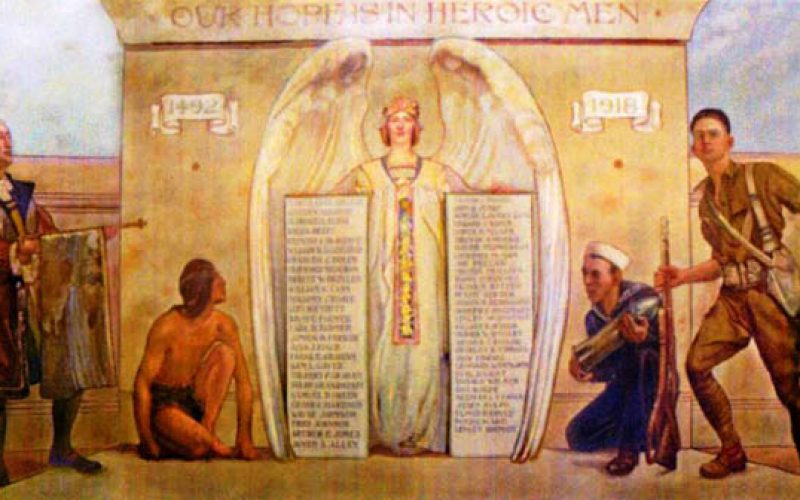DAR wants historic mural noticed
BECCA MARTIN-BROWN
NWA Democrat-Gazette

The Free Weekly/ANDY SHUPE
The mural in the Historic Washington County Courthouse is the topic of a Sandwiched In program Wednesday at the Shiloh Museum.
If you didn’t know better, you might think LaNita Terry McKinney and Cheri Coley are talking about the latest machinations on “Game of Thrones.” Both of them can rattle off names and events that happened long before they were born — some secrets, some scandals, all of them documented far beyond the limits of Ancestry.com.
They are Daughters of the American Revolution. And they know things.
“DAR is a lineage society,” McKinney explains with the enthusiasm of a true believer. When she married, “my husband’s mother and sister were in DAR, and I took it as a challenge for me to try to prove” she had a “patriot” in her family tree.
She effortlessly rattles off the lineage to the ancestor who earned her her DAR membership:
LaNita Carol Terry to Carol Sue Cullen to Oleva Angelina Sivage to Olivia Louisa Patterson to Charles Daniel Patterson to Lucy Hayes Hall to Nancy Sweeney to Daniel Sweeney to Moses Sweeney.
Now she has four to whom she can trace direct relationships, including three who served in the military during the American Revolution and one who was a Quaker but furnished beef to American troops.

NWA Democrat-Gazette/ANDY SHUPE
The mural in the Historic Washington County Courthouse Thursday, Aug. 3, 2017, in Fayetteville.
Coley, who has proved six patriots, says she knew she was eligible for “years and years,” having grown up being “dragged to cemetery decorations.” “I thought I’d be a rebel and shake those blue-haired ladies up,” she says of joining Marion Chapter of the DAR. “Now I am one.”
Lately, the two women have been working on a different kind of research. On Wednesday, they’ll speak at a Sandwiched In program at the Shiloh Museum of Ozark History on the World War I mural in the Historic Washington County Courthouse. The connection? Marion Chapter commissioned the mural in 1920 to honor local soldiers killed in World War I, which the U.S. entered 100 years ago in 1917. New York artist William Robert Steene just happened to be living in Fayetteville at the time, and on Feb. 21, 1920, the women of the chapter voted “that regent make an appointment with the artist Mr. Steene for DAR to meet in body at his studio, see his work and hear his [plan] for raising money with which to pay for said memorial, which will be a mural painting placed in courthouse.”
According to McKinney’s and Coley’s research, the mural was painted on heavy canvas in Steene’s studio, then transported to the Ozark Theatre for unveiling on July 5, 1921. “The event was held at the Ozark Theatre because its stage was the only place in the city capable of holding the 8 feet by 36 feet wide mural.”
By newspaper accounts, the unveiling was “impressive in the extreme.” The names of 53 — or maybe 54 — killed in war were read aloud by a World War I veteran, Col. W.G. Owenbey, and shortly thereafter, the mural was moved to the courthouse.

NWA Democrat-Gazette/ANDY SHUPE
The mural in the Historic Washington County Courthouse Thursday, Aug. 3, 2017, in Fayetteville.
Fast forward to 1976, when the local DAR led a drive to clean and restore the mural, then to 2009-10, when another restoration was undertaken to coincide with the renovations at the historic courthouse. Now, the women agree, history lovers need to be reminded of the mural since the building is no longer the center of Washington County.
“History is important,” Coley says. “We need to preserve what we have been given. If we want to ‘keep Fayetteville funky,’ we need to give credit to folks who came before.”
Both women hope they might also inspire an interest in genealogy. The Marion Chapter’s lineage committee meets Mondays from 5:30 to 7:30 p.m. at the Fayetteville Public Library to help those interested in their roots.
“We won’t do it for you,” Coley says, “but we’ll hold your hand.”
They also want their audience to know members of the DAR “don’t sit around and eat bonbons.” Founded in 1890, the DAR’s objectives are historic preservation, education and patriotism. And if they can recruit new converts, so much the better.
FAQ
Sandwiched In:
World War I Mural
WHEN — Noon Wednesday
WHERE — Shiloh Museum of Ozark History in Springdale
COST — Free
INFO — 750-8165



